Behaviour of a Sustainable Concrete in Acidic Environment
Abstract
:1. Introduction
2. Experimental Programme
2.1. Materials
2.2. Mix Proportions
2.3. Specimen Preparation
2.4. Test Methods
2.4.1. Compressive Strength
2.4.2. Strength and Mass Loss
2.4.3. Scanning Electron Microscope (SEM)
3. Results and Discussion
3.1. Compressive Strength Development
3.2. Behaviour in Sulphuric Acid Environment
3.3. Behaviour in Nitric Acid Environment
3.4. Visual Inspection
3.5 Microstructural Observation from SEM
4. Conclusions
- In sulphuric acid environment, the compressive strength loss was minimum for a concrete mix in which cement was replaced with 30% fly ash and 10% ultra fine fly ash. The mass loss was less in this mix compared to the mix without fly ash. However, mass loss was also less in mixes containing higher amounts of fly ash.
- In nitric acid environment, concrete mixes containing 20% fly ash and 10% ultra fine fly ash and 30% fly ash and 10% ultra fine fly ash had the minimum compressive strength loss. However, the mass loss in mix containing 30% fly ash and 10% ultra fine fly ash was less than the mix containing 20% fly ash and 10% ultra fine fly ash.
- The SEM image of concrete mix with 30% fly ash and 10% ultra fine fly ash cured in water for 28 days showed denser microstructure characterised by less amounts of calcium hydride crystals. The SEM image of concrete mix containing 30% fly ash and 10% ultra fine fly ash exposed to sulphuric acid for 28 days showed that the surface is highly porous. A noticeable amount of C-S-H gel appears to have been decomposed into finer particles. When the same mix was exposed to nitric acid for a period of 28 days, the SEM image showed that the surface is very porous, with the salt by-products on the surface caused by the reaction of the acid with the calcium hydroxide.
Author Contributions
Conflicts of Interest
References
- Flower, D.; Sanjayan, J.; Baweja, D. Environmental impacts of concrete production and construction. In Proceedings of the Concrete Institute of Australia Biennial Conference, Melbourne, Australia, 17–19 October 2005. [Google Scholar]
- Han, S.H.; Kim, J.K.; Park, Y.D. Prediction of compressive strength of fly ash concrete. Cem. Concr. Res. 2003, 33, 965–971. [Google Scholar] [CrossRef]
- Malhotra, V.M. Durability of concrete incorporating high-volume of low calcium (ASTM class F) fly ash. Cem. Concr. Compos. 1990, 12, 487–493. [Google Scholar] [CrossRef]
- Bilodeau, A.; Malhotra, V.M. High-volume fly ash system: Concrete solution for sustainable development. ACI Mater. J. 2000, 97, 41–48. [Google Scholar]
- Langey, W.S.; Carette, G.G.; Malhotra, V.M. Strength development and temperature rise in large concrete blocks containing high-volumes of low-calcium (ASTM class F) fly ash. ACI Mater. J. 1992, 89, 362–368. [Google Scholar]
- Standards Australia. Australian Standard AS3582.1, Supplementary Cementitious Materials for Use with Portland and Blended Cement—Part 1: Fly Ash; Standards Australia International: Sydney, Australia, 1998. [Google Scholar]
- Standards Australia. Australian Standard AS3972, General Purpose and Blended Cements; Standards Australia International: Sydney, Australia, 2010. [Google Scholar]
- Malhotra, V.M.; Zhang, M.H.; Read, P.H.; Ryell, J. Long-term mechanical properties and durability characteristics of high-strength/high-performance concrete incorporating supplementary cementing materials under outdoor exposure conditions. ACI Mater. J. 2000, 97, 518–525. [Google Scholar]
- Xu, A.; Sarkar, S.L. Microstructural study of gypsum activated fly ash hydration in cement paste. Cem. Concr. Res. 1991, 21, 1137–1147. [Google Scholar]
- Paya, J.; Monzo, J.; Borrachero, M.V. Mechanical treatment of fly ashes: Part III. Studies on strength development of ground fly ashes. Cem. Concr. Res. 1997, 27, 1365–1377. [Google Scholar] [CrossRef]
- Katz, A. Microstructure study of alkali-activated fly ash. Cem. Concr. Res. 1998, 28, 197–208. [Google Scholar] [CrossRef]
- Barbhuiya, S.; Gbagbo, J.; Russell, M.; Basheer, M. Properties of fly ash concrete modified with hydrated lime and silica fume. Constr. Build. Mater. 2009, 23, 3233–3239. [Google Scholar] [CrossRef]
- Nochaiya, T.; Wongkeo, W.; Chaipanich, A. Utilization of fly ash with silica fume and properties of Portland cement fly ash-silica fume concrete. Fuel 2010, 89, 768–774. [Google Scholar] [CrossRef]
- Gesoglu, M.; Gunevisi, E.; Ozbav, E. Properties of self-compacting concretes made with binary, ternary, and quaternary cementitious blends of fly ash, blast furnace slag, and silica fume. Constr. Build. Mater. 2009, 23, 1847–1854. [Google Scholar] [CrossRef]
- Bingol, A.F.; Tohumcu, I. Effects of different curing regimes on the compressive strength properties of self-compacting concrete incorporating fly ash and silica fume. Mater. Des. 2013, 51, 12–18. [Google Scholar] [CrossRef]
- Obla, K.H.; Hill, R.L.; Shashiprakash, S.G.; Perebatova, O. Properties of concrete containing ultra-fine fly ash. ACI Mater. J. 2003, 100, 426–433. [Google Scholar]
- Subramaniam, K.V.; Gromotka, R.; Shah, S.P.; Obla, K.; Hill, R. Influence of ultrafine fly ash on the early age response and the shrinkage cracking potential of concrete. J. Mater. Civ. Eng. 2005, 17, 45–53. [Google Scholar] [CrossRef]
- Chindaprasirt, P.; Jaturapitakkul, C.; Sinsiri, T. Effect of fly ash fineness on compressive strength and pore size of blended cement paste. Cem. Concr. Compos. 2005, 27, 425–428. [Google Scholar] [CrossRef]
- Choi, S.; Lee, S.S.; Monteiro, P.J.M. Effect of Fly ash fineness on temperature rise, setting, and strength development of mortar. J. Mater. Civ. Eng. 2012, 24, 499–505. [Google Scholar] [CrossRef]
- Shaikh, F.U.A.; Supit, S.W.M. Compressive strength and durability properties of high volume fly ash (HVFA) concretes containing ultrafine fly ash (UFFA). Constr. Build. Mater. 2015, 82, 192–205. [Google Scholar] [CrossRef]
- Shi, C.; Stegemann, J.A. Acid corrosion resistance of different cementing materials. Cem. Concr. Res. 2000, 30, 803–808. [Google Scholar] [CrossRef]
- Monteny, J.; Vincke, E.; Beeldeens, A.; De Belie, N.; Taerwe, L.; Gemert, D.; Verstraete, W. Chemical, microbiological, and in situ test methods for biogenic sulfuric acid corrosion of concrete. Cem. Concr. Res. 2000, 30, 623–634. [Google Scholar] [CrossRef]
- Monteny, J.; Belie, N.D.; Vincke, E.; Verstraete, W.; Taerwe, L. Chemical and microbiological tests to simulate sulfuric acid corrosion of polymer-modified concrete. Cem. Concr. Res. 2001, 31, 1359–1365. [Google Scholar] [CrossRef]
- Lee, S.; Hooton, R.; Jung, H.; Park, D.; Choi, C. Effect of limestone filler on the deterioration of mortars and pastes exposed to sulfate solutions at ambient temperature. Cem. Concr. Res. 2008, 38, 68–76. [Google Scholar] [CrossRef]
- Roy, D.M.; Arjunan, P.; Silsbee, M.R. Effect of silica fume, metakaolin and low-calcium fly ash on chemical resistance of concrete. Cem. Concr. Res. 2001, 31, 1809–1813. [Google Scholar] [CrossRef]
- Monteny, J.; Belie, N.D.; Taerwe, L. Resistance of different types of concrete mixtures to sulphuric acid. Mater. Struct. 2003, 36, 242–249. [Google Scholar] [CrossRef]
- Baret, G.; Poppe, A.M.; Belie, N.D. Strength and durability of high-volume fly ash concrete. Struct. Concr. 2008, 9, 101–108. [Google Scholar]
- Standards Australia. AS 1012.9-2014 Methods of Testing Concrete Compressive Strength Tests—Concrete, Mortar and Grout Specimens; Standards Australia: Sydney, Australia, 2014. [Google Scholar]
- Hewayde, E.; Nehdi, M.; Allouche, E.; Nakhla, G. Using concrete admixtures for sulphuric acid resistance. Constr. Mater. 2007, 160, 25–35. [Google Scholar] [CrossRef]
- Goyal, S.; Kumar, M.; Sidhu, D.S.; Bhattacharjee, B. Resistance of mineral admixture concrete to acid attack. J. Adv. Concr. Technol. 2009, 7, 273–283. [Google Scholar] [CrossRef]
- Zivica, V.; Bajza, A. Acidic attack of cement based materials—A review Part 2. Factors of rate of acidic attack and protective measures. Constr. Build. Mater. 2002, 16, 215–222. [Google Scholar] [CrossRef]
- Mehta, P.K.; Monteiro, P.J.M. Concrete: Microstructure, Properties, and Materials, 3rd ed.; McGraw-Hill Comapnes Inc.: New York, NY, USA, 2006; p. 659. [Google Scholar]
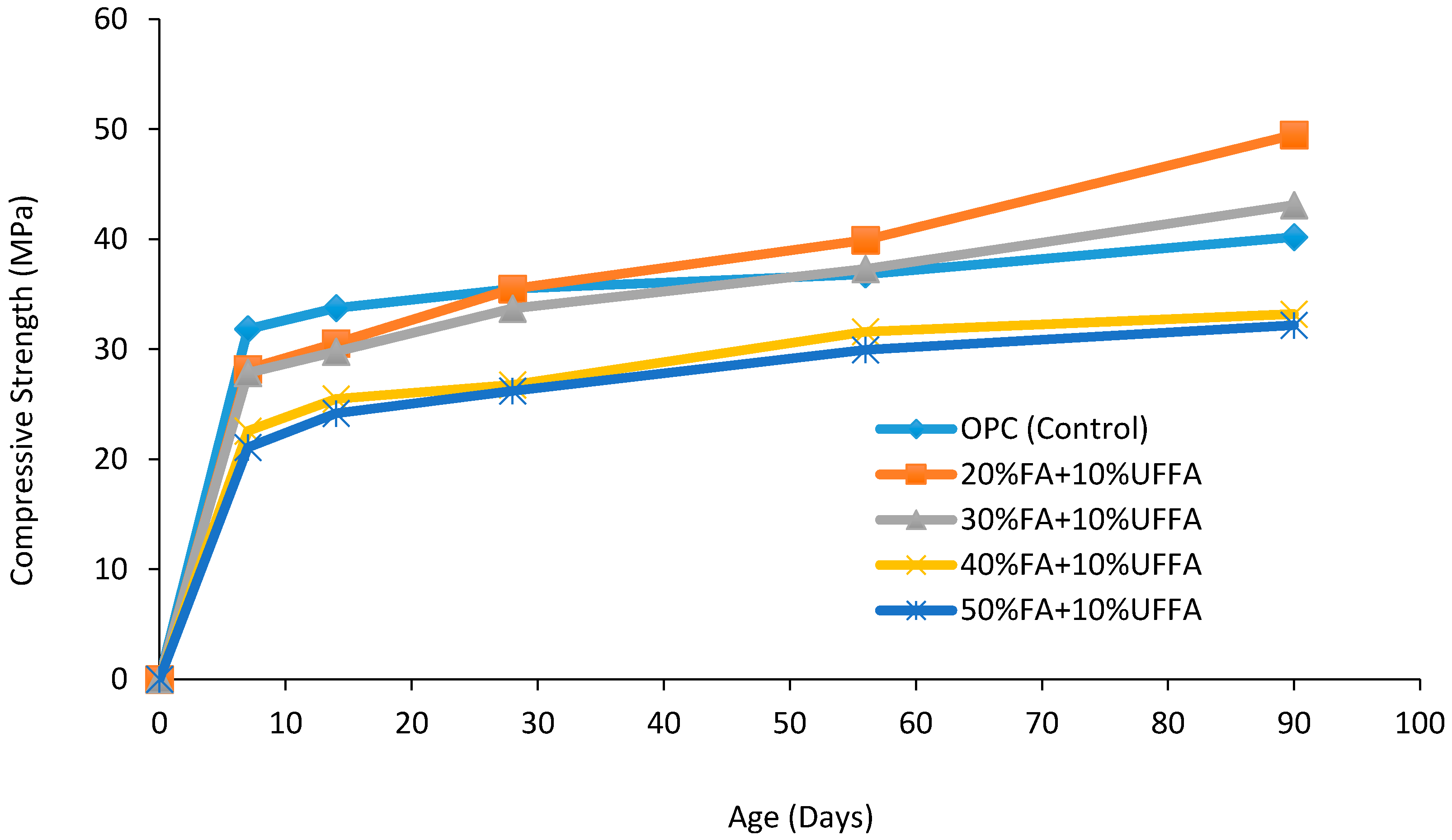
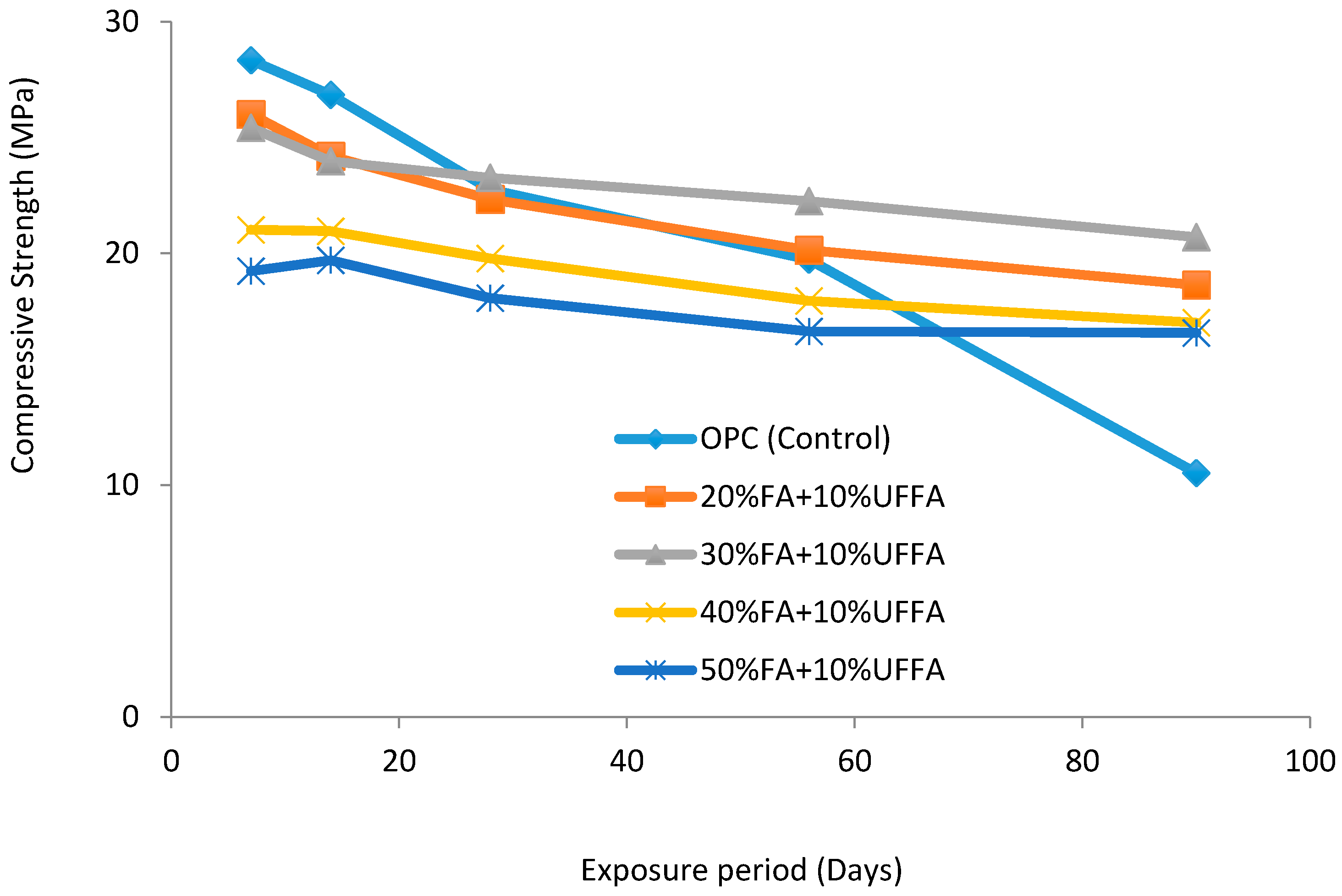
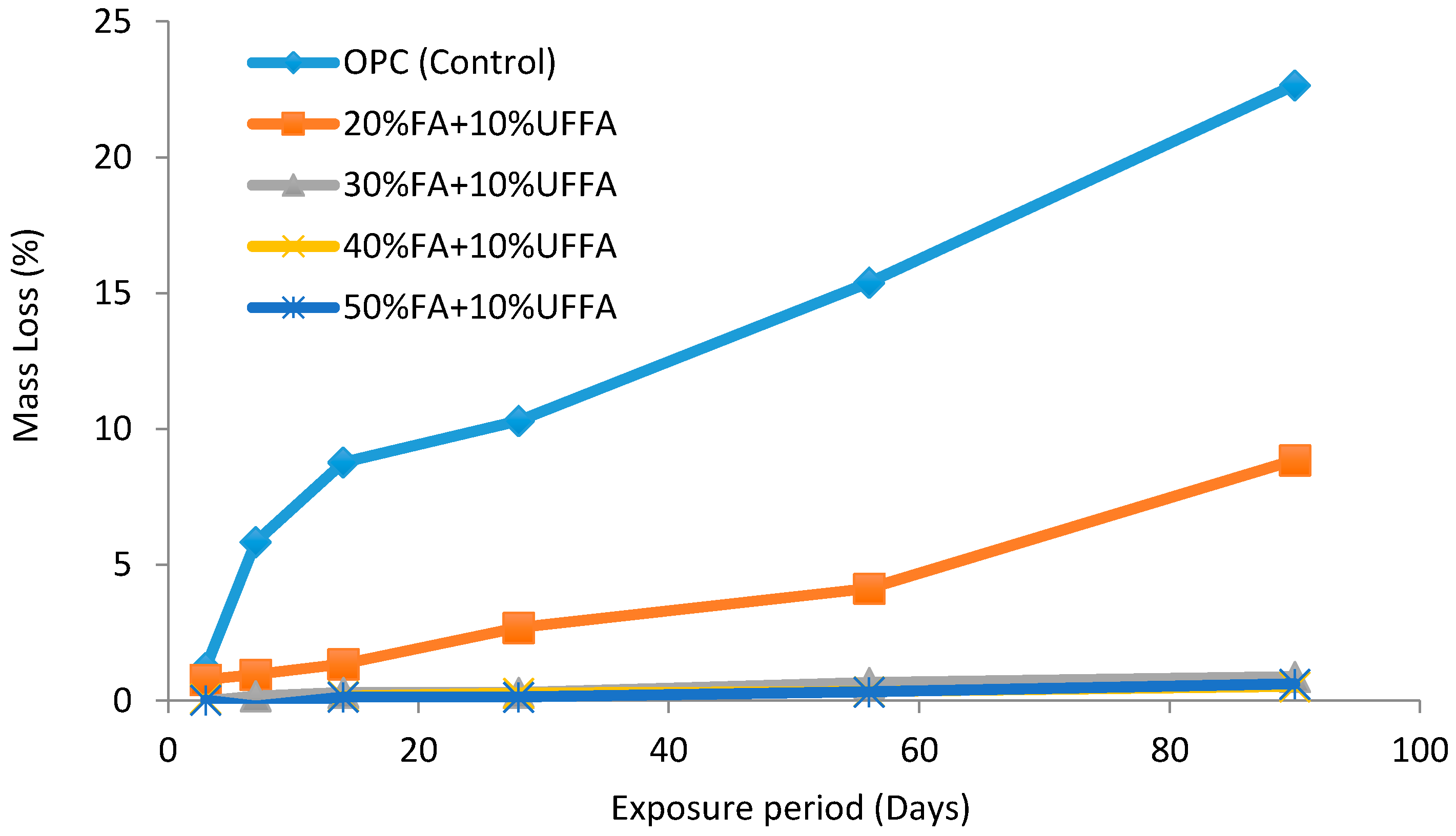
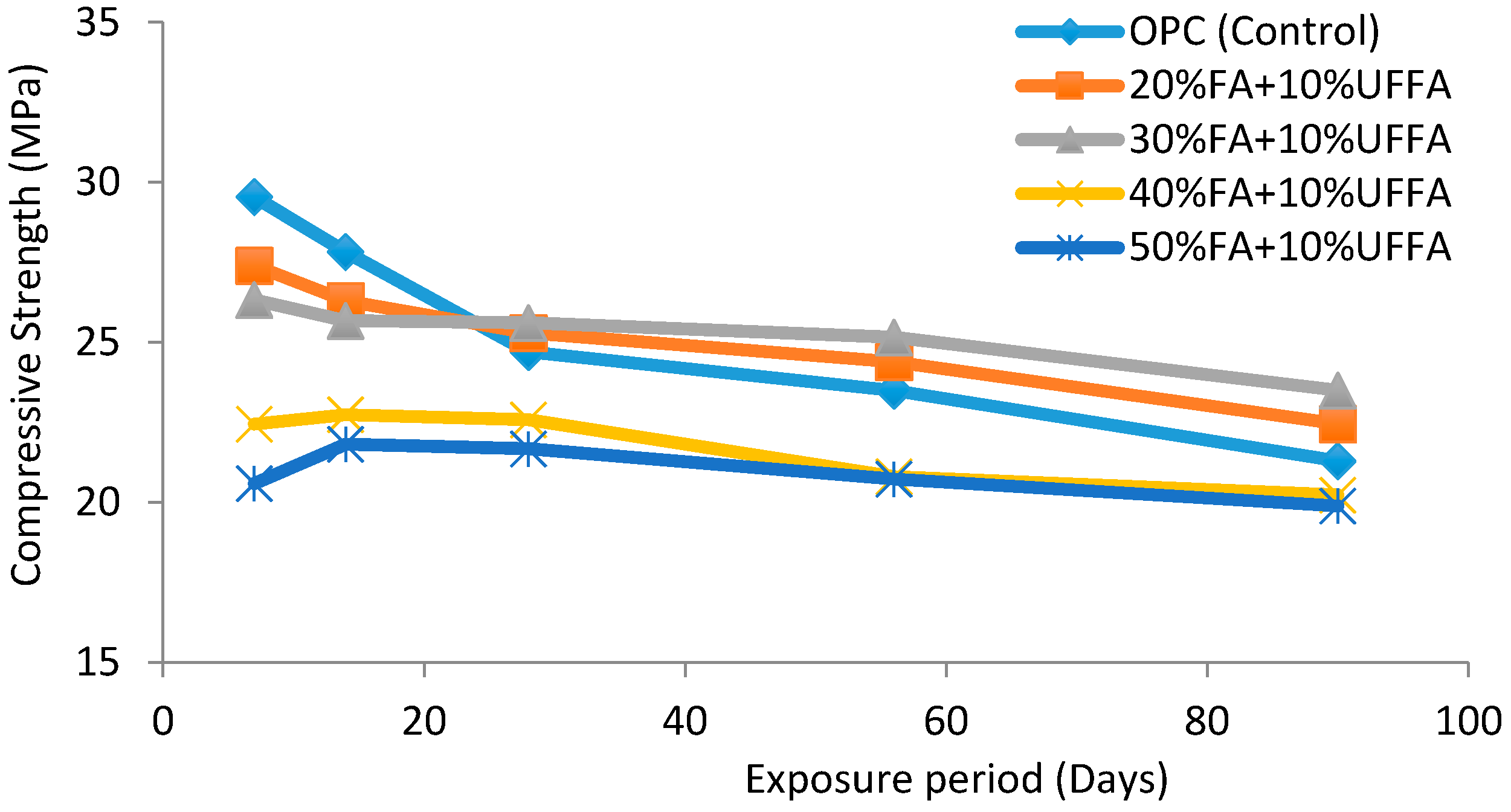
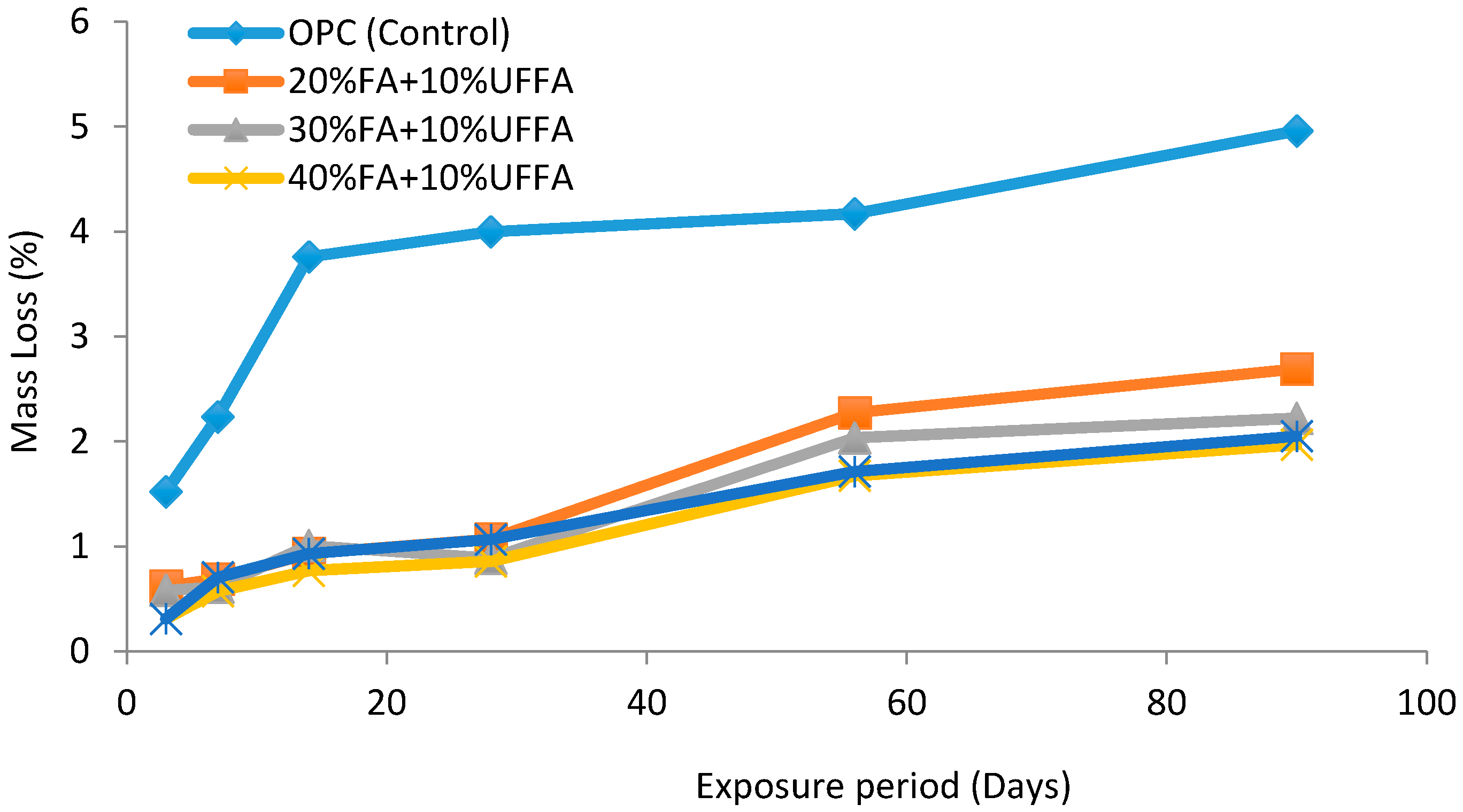
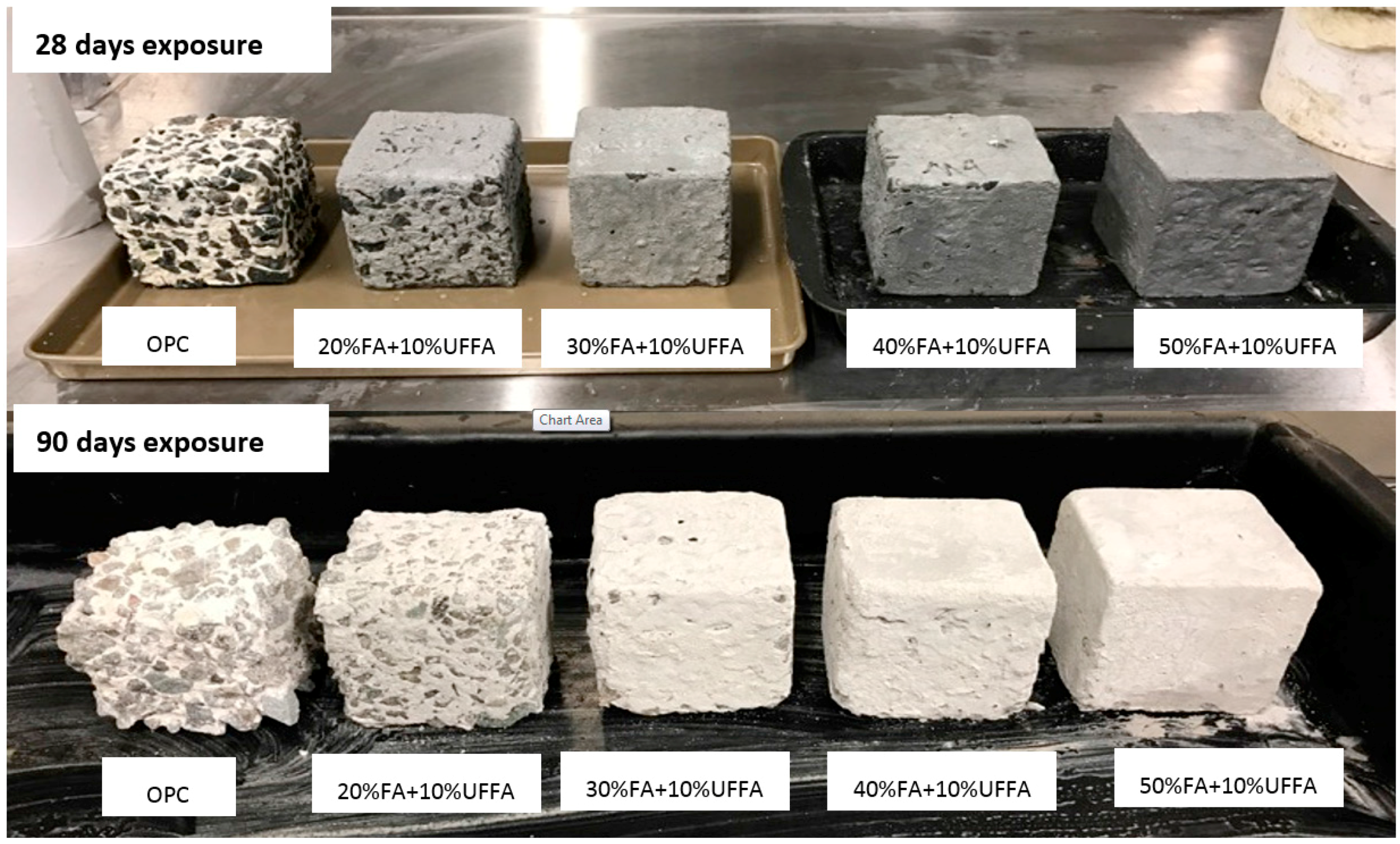
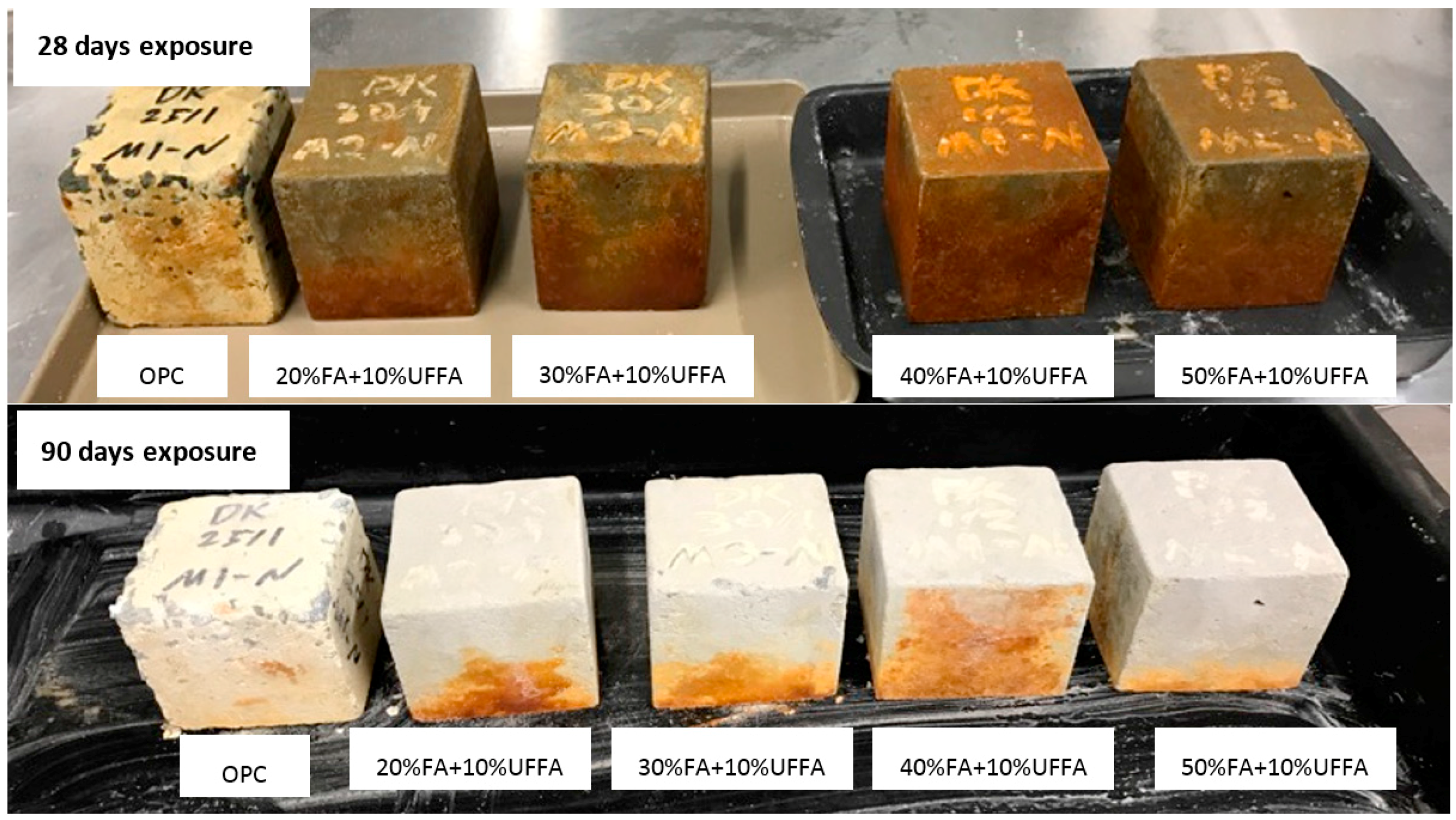

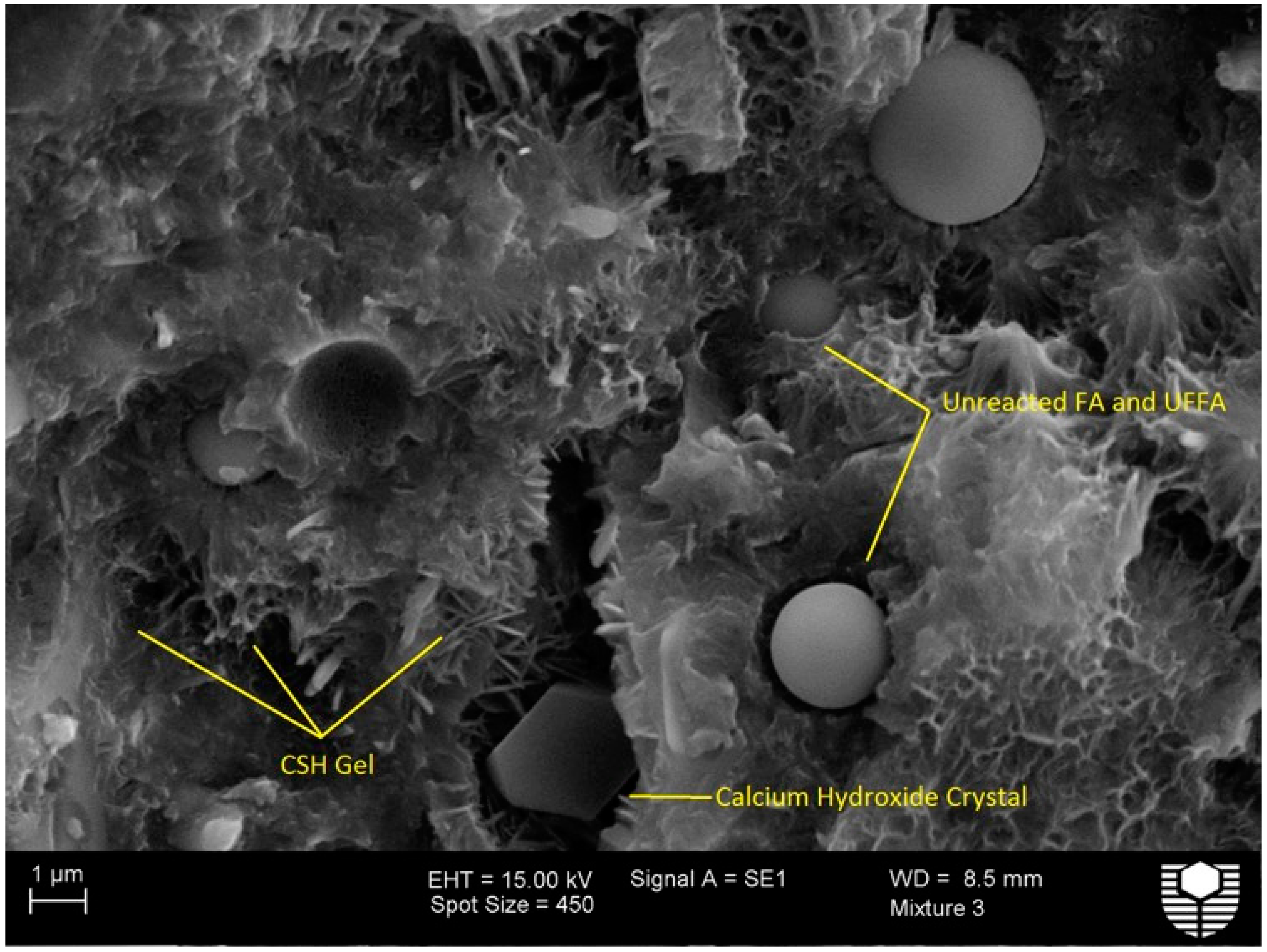
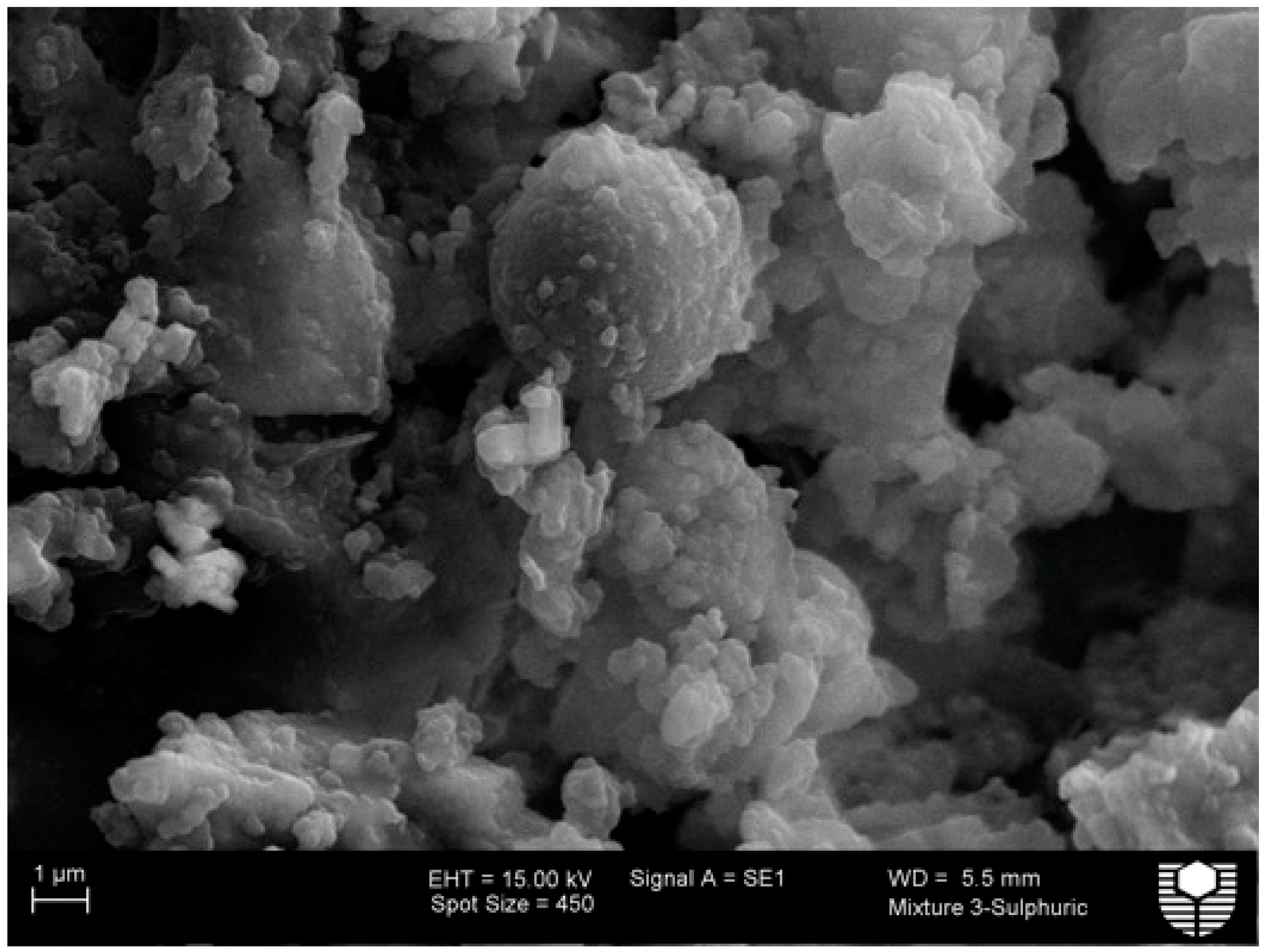
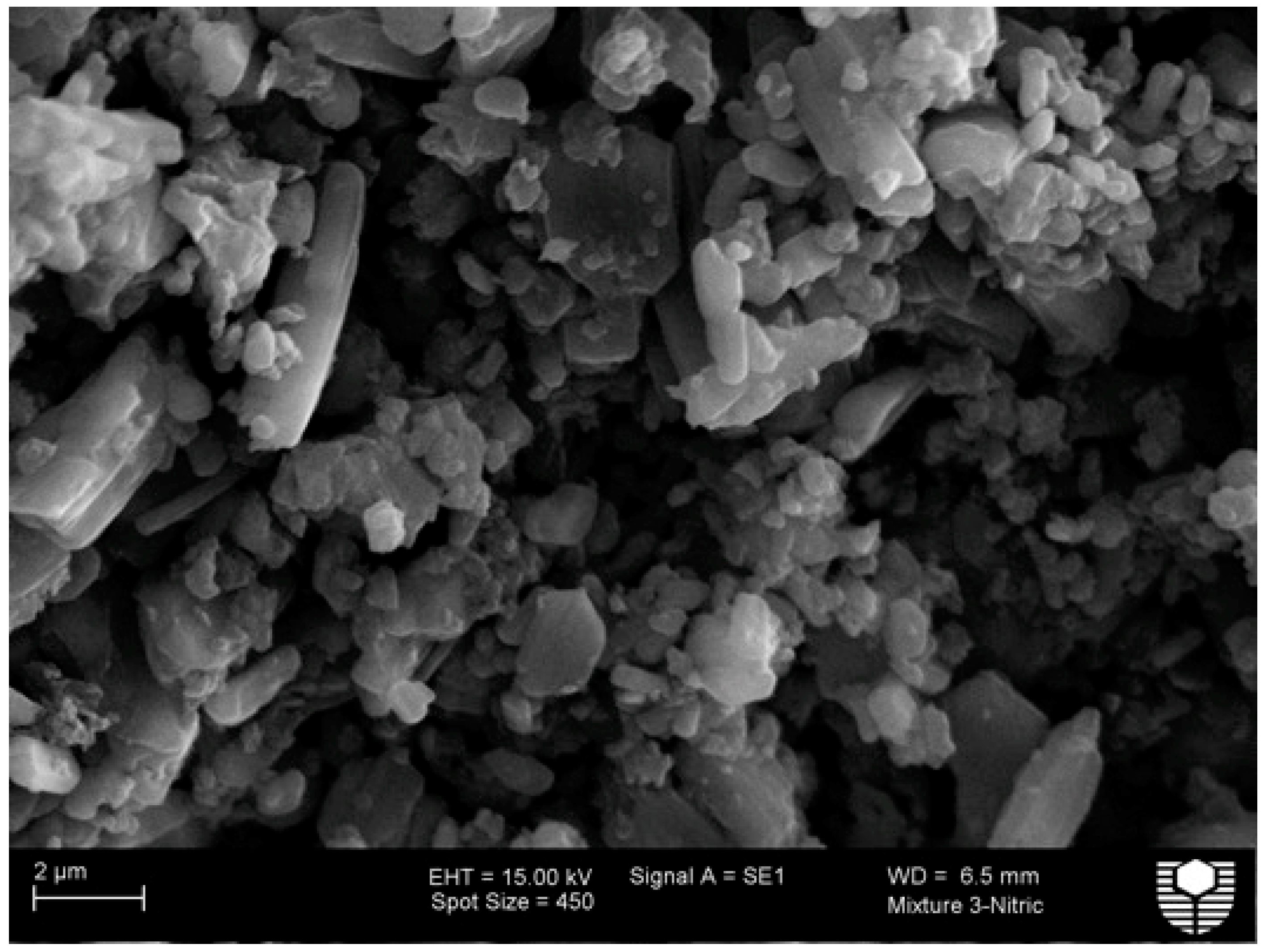
| Chemical Composition | |||
| Oxides | Cement (%) | Fly Ash (%) | Ultra Fine Fly Ash (%) |
| SiO2 | 21.1 | 51.8 | 73.4 |
| AI2O3 | 4.7 | 26.4 | 17.7 |
| Fe2O3 | 2.8 | 13.2 | 4.4 |
| CaO | 63.8 | 1.61 | 0.9 |
| MgO | 2.0 | 1.1.7 | 0.6 |
| MnO | - | 0.10 | 0.1 |
| K2O | - | 0.68 | 1.03 |
| Na2O | - | 0.31 | 0.11 |
| P2O5 | - | 1.39 | 0.20 |
| TiO2 | - | 1.44 | 0.70 |
| SO3 | 2.4 | 0.21 | 0.20 |
| Physical Properties | |||
| Particle Size | 25–40% ≤7 μm | 40% of 10 μm | Mean Size 3.4 μm |
| Specific gravity | 2.7–3.2 | 2.6 | 2.0–2.55 |
| Surface area (m2/kg) | 352 | 340 | 2510 |
| Loss of Ignition (%) | 2.4 | 0.50 | 0.60 |
| Mix No. | Mix ID | kg/m3 | SP * (%) | |||||
|---|---|---|---|---|---|---|---|---|
| OPC | FA | UFFA | Water | Fine Aggregate | Coarse Aggregate | |||
| Mix 1 | OPC (control) | 400 | 0 | - | 140 | 600 | 1250 | 0 |
| Mix 2 | 20% FA + 10% UFFA | 280 | 80 | 40 | 140 | 600 | 1250 | 0.5 |
| Mix 3 | 30% FA + 10% UFFA | 240 | 120 | 40 | 140 | 600 | 1250 | 1.0 |
| Mix 4 | 40% FA + 10% UFFA | 200 | 160 | 40 | 140 | 600 | 1250 | 1.2 |
| Mix 5 | 50% FA + 10% UFFA | 160 | 200 | 40 | 140 | 600 | 1250 | 1.5 |
| Mix No. | Mix ID | 7 Days (MPa) (Avg ± SD) | 14 Days (MPa) (Avg ± SD) | 28 Days (MPa) (Avg ± SD) | 56 Days (MPa) (Avg ± SD) | 90 Days (MPa) (Avg ± SD) |
|---|---|---|---|---|---|---|
| Mix 1 | OPC (control) | 31.67 ± 0.25 | 33.53 ± 0.59 | 35.37 ± 1.16 | 36.23 ± 2.59 | 40.13 ± 0.15 |
| Mix 2 | 20% FA + 10% UFFA | 28.37 ± 0.32 | 29.60 ± 1.73 | 35.3 ± 2.31 | 40.17 ± 2.48 | 49.00 ± 1.23 |
| Mix 3 | 30% FA + 10% UFFA | 27.60 ± 0.30 | 29.53 ± 1.76 | 33.50 ± 0.53 | 37.30 ± 1.45 | 42.73 ± 0.60 |
| Mix 4 | 40% FA + 10% UFFA | 22.43 ± 0.85 | 25.60 ± 0.35 | 26.53 ± 0.40 | 31.47 ± 0.74 | 33.27 ± 0.91 |
| Mix 5 | 50% FA + 10% UFFA | 20.97 ± 1.72 | 24.03 ± 0.68 | 26.07 ± 1.42 | 29.33 ± 1.64 | 32.50 ± 1.31 |
| Mix No. | Mix ID | 7 Days (MPa) (Avg ± SD) | 14 Days (MPa) (Avg ± SD) | 28 Days (MPa) (Avg ± SD) | 56 Days (MPa) (Avg ± SD) | 90 Days (MPa) (Avg ± SD) |
|---|---|---|---|---|---|---|
| Mix 1 | OPC (control) | 27.93 ± 2.84 | 26.70 ± 1.08 | 22.57 ± 0.42 | 19.53 ± 1.50 | 10.73 ± 3.17 |
| Mix 2 | 20% FA + 10% UFFA | 25.80 ± 1.25 | 24.17 ± 1.08 | 22.40 ± 0.20 | 20.17 ± 1.25 | 18.37 ± 2.37 |
| Mix 3 | 30% FA + 10% UFFA | 25.07 ± 1.61 | 23.97 ± 0.40 | 23.23 ± 0.32 | 22.20 ± 0.10 | 20.77 ± 0.35 |
| Mix 4 | 40% FA + 10% UFFA | 21.37 ± 2.97 | 20.70 ± 2.29 | 19.20 ± 2.08 | 17.67 ± 0.51 | 16.70 ± 0.66 |
| Mix 5 | 50% FA + 10% UFFA | 19.20 ± 0.26 | 19.77 ± 1.01 | 18.07 ± 1.85 | 16.73 ± 1.56 | 16.37 ± 0.32 |
| Mix No. | Mix ID | 3 Days (MPa) (Avg ± SD) | 7 Days (MPa) (Avg ± SD) | 14 Days (MPa) (Avg ± SD) | 28 Days (MPa) (Avg ± SD) | 56 Days (MPa) (Avg ± SD) | 90 Days (MPa) (Avg ± SD) |
|---|---|---|---|---|---|---|---|
| Mix 1 | OPC (control) | 1.22 ± 0.08 | 5.82 ± 0.24 | 8.78 ± 0.12 | 10.35 ± 0.49 | 15.40 ± 0.45 | 22.64 ± 0.35 |
| Mix 2 | 20% FA + 10% UFFA | 0.77 ± 0.05 | 0.96 ± 0.12 | 1.35 ± 0.08 | 2.68 ± 0.36 | 4.15 ± 0.17 | 8.89 ± 1.04 |
| Mix 3 | 30% FA + 10% UFFA | 0.13 ± 0.14 | 0.17 ± 0.06 | 0.36 ± 0.15 | 0.30 ± 0.07 | 0.65 ± 0.04 | 0.88 ± 0.08 |
| Mix 4 | 40% FA + 10% UFFA | 0.09 ± 0.08 | 0.28 ± 0.05 | 0.17 ± 0.08 | 0.28 ± 0.06 | 0.34 ± 0.03 | 0.52 ± 0.07 |
| Mix 5 | 50% FA + 10% UFFA | 0.04 ± 0.03 | 0.27 ± 0.09 | 0.15 ± 0.08 | 0.14 ± 0.03 | 0.34 ± 0.05 | 0.61 ± 0.08 |
| Mix No. | Mix ID | 7 Days (MPa) (Avg ± SD) | 14 Days (MPa) (Avg ± SD) | 28 Days (MPa) (Avg ± SD) | 56 Days (MPa) (Avg ± SD) | 90 Days (MPa) (Avg ± SD) |
|---|---|---|---|---|---|---|
| Mix 1 | OPC (control) | 29.40 ± 0.26 | 27.60 ± 2.19 | 24.03 ± 1.40 | 23.47 ± 0.40 | 21.23 ± 0.49 |
| Mix 2 | 20% FA + 10% UFFA | 27.30 ± 0.44 | 26.27 ± 0.21 | 24.60 ± 1.50 | 24.53 ± 0.86 | 22.50 ± 0.10 |
| Mix 3 | 30% FA + 10% UFFA | 26.23 ± 0.25 | 25.73 ± 0.38 | 25.53 ± 0.61 | 25.13 ± 0.15 | 23.40 ± 2.01 |
| Mix 4 | 40% FA + 10% UFFA | 22.27 ± 1.78 | 22.70 ± 0.56 | 22.40 ± 0.46 | 20.83 ± 0.25 | 20.13 ± 0.49 |
| Mix 5 | 50% FA + 10% UFFA | 20.60 ± 0.50 | 21.67 ± 1.42 | 21.73 ± 0.31 | 20.73 ± 0.65 | 20.10 ± 0.46 |
| Mix No. | Mix ID | 3 Days (MPa) (Avg ± SD) | 7 Days (MPa) (Avg ± SD) | 14 Days (MPa) (Avg ± SD) | 28 Days (MPa) (Avg ± SD) | 56 Days (MPa) (Avg ± SD) | 90 Days (MPa) (Avg ± SD) |
|---|---|---|---|---|---|---|---|
| Mix 1 | OPC (control) | 1.52 ± 0.08 | 2.22 ± 0.19 | 3.64 ± 0.57 | 4.09 ± 0.23 | 4.17 ± 0.45 | 4.79 ± 0.89 |
| Mix 2 | 20% FA + 10% UFFA | 0.62 ± 0.05 | 0.68 ± 0.08 | 0.94 ± 0.05 | 1.08 ± 0.11 | 2.28 ± 0.43 | 2.65 ± 0.53 |
| Mix 3 | 30% FA + 10% UFFA | 0.58 ± 0.03 | 0.62 ± 0.07 | 1.08 ± 0.24 | 0.89 ± 0.09 | 2.09 ± 0.59 | 2.23 ± 0.29 |
| Mix 4 | 40% FA + 10% UFFA | 0.30 ± 0.020 | 0.57 ± 0.08 | 0.92 ± 0.04 | 0.85 ± 0.06 | 1.67 ± 0.22 | 1.96 ± 0.67 |
| Mix 5 | 50% FA + 10% UFFA | 0.31 ± 0.04 | 0.69 ± 0.08 | 1.09 ± 0.23 | 1.08 ± 0.17 | 1.74 ± 0.24 | 2.07 ± 0.43 |
© 2017 by the authors. Licensee MDPI, Basel, Switzerland. This article is an open access article distributed under the terms and conditions of the Creative Commons Attribution (CC BY) license (http://creativecommons.org/licenses/by/4.0/).
Share and Cite
Barbhuiya, S.; Kumala, D. Behaviour of a Sustainable Concrete in Acidic Environment. Sustainability 2017, 9, 1556. https://doi.org/10.3390/su9091556
Barbhuiya S, Kumala D. Behaviour of a Sustainable Concrete in Acidic Environment. Sustainability. 2017; 9(9):1556. https://doi.org/10.3390/su9091556
Chicago/Turabian StyleBarbhuiya, Salim, and Davin Kumala. 2017. "Behaviour of a Sustainable Concrete in Acidic Environment" Sustainability 9, no. 9: 1556. https://doi.org/10.3390/su9091556
APA StyleBarbhuiya, S., & Kumala, D. (2017). Behaviour of a Sustainable Concrete in Acidic Environment. Sustainability, 9(9), 1556. https://doi.org/10.3390/su9091556





